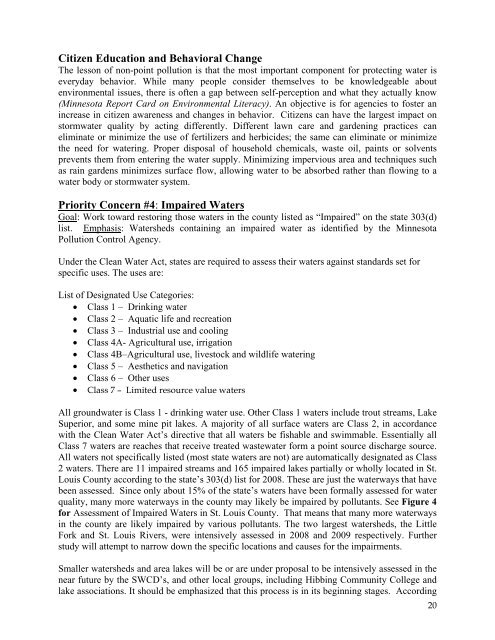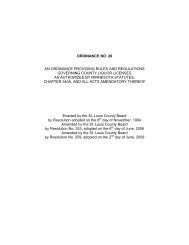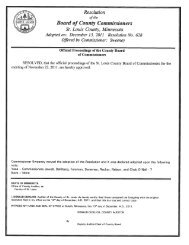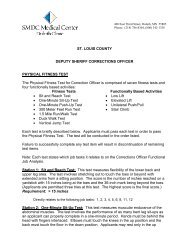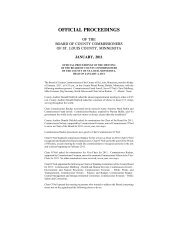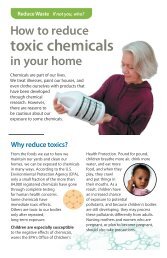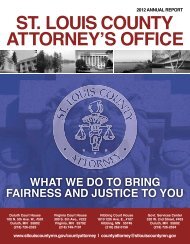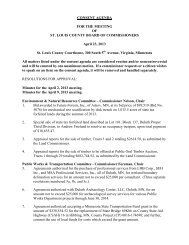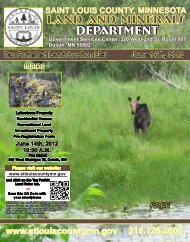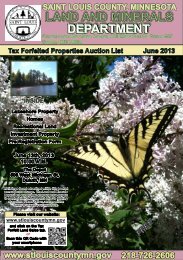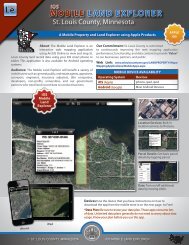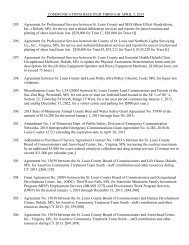Comprehensive Water Management Plan - St. Louis County
Comprehensive Water Management Plan - St. Louis County
Comprehensive Water Management Plan - St. Louis County
Create successful ePaper yourself
Turn your PDF publications into a flip-book with our unique Google optimized e-Paper software.
Citizen Education and Behavioral ChangeThe lesson of non-point pollution is that the most important component for protecting water iseveryday behavior. While many people consider themselves to be knowledgeable aboutenvironmental issues, there is often a gap between self-perception and what they actually know(Minnesota Report Card on Environmental Literacy). An objective is for agencies to foster anincrease in citizen awareness and changes in behavior. Citizens can have the largest impact onstormwater quality by acting differently. Different lawn care and gardening practices caneliminate or minimize the use of fertilizers and herbicides; the same can eliminate or minimizethe need for watering. Proper disposal of household chemicals, waste oil, paints or solventsprevents them from entering the water supply. Minimizing impervious area and techniques suchas rain gardens minimizes surface flow, allowing water to be absorbed rather than flowing to awater body or stormwater system.Priority Concern #4: Impaired <strong>Water</strong>sGoal: Work toward restoring those waters in the county listed as “Impaired” on the state 303(d)list. Emphasis: <strong>Water</strong>sheds containing an impaired water as identified by the MinnesotaPollution Control Agency.Under the Clean <strong>Water</strong> Act, states are required to assess their waters against standards set forspecific uses. The uses are:List of Designated Use Categories:• Class 1 – Drinking water• Class 2 – Aquatic life and recreation• Class 3 – Industrial use and cooling• Class 4A- Agricultural use, irrigation• Class 4B–Agricultural use, livestock and wildlife watering• Class 5 – Aesthetics and navigation• Class 6 – Other uses• Class 7 – Limited resource value watersAll groundwater is Class 1 - drinking water use. Other Class 1 waters include trout streams, LakeSuperior, and some mine pit lakes. A majority of all surface waters are Class 2, in accordancewith the Clean <strong>Water</strong> Act’s directive that all waters be fishable and swimmable. Essentially allClass 7 waters are reaches that receive treated wastewater form a point source discharge source.All waters not specifically listed (most state waters are not) are automatically designated as Class2 waters. There are 11 impaired streams and 165 impaired lakes partially or wholly located in <strong>St</strong>.<strong>Louis</strong> <strong>County</strong> according to the state’s 303(d) list for 2008. These are just the waterways that havebeen assessed. Since only about 15% of the state’s waters have been formally assessed for waterquality, many more waterways in the county may likely be impaired by pollutants. See Figure 4for Assessment of Impaired <strong>Water</strong>s in <strong>St</strong>. <strong>Louis</strong> <strong>County</strong>. That means that many more waterwaysin the county are likely impaired by various pollutants. The two largest watersheds, the LittleFork and <strong>St</strong>. <strong>Louis</strong> Rivers, were intensively assessed in 2008 and 2009 respectively. Furtherstudy will attempt to narrow down the specific locations and causes for the impairments.Smaller watersheds and area lakes will be or are under proposal to be intensively assessed in thenear future by the SWCD’s, and other local groups, including Hibbing Community College andlake associations. It should be emphasized that this process is in its beginning stages. According20


